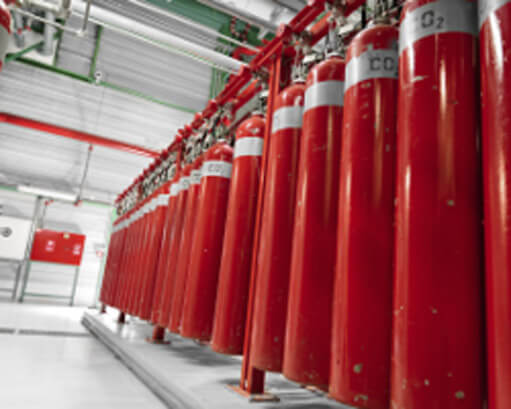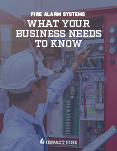Special hazard fire suppression systems use advanced detection technologies, custom setups, and different suppression agents to effectively extinguish fires without damaging building contents, endangering facility occupants, or compromising business continuity.

Special hazard fire protection systems extinguish fires quickly without endangering building occupants or destroying the critical assets they were designed to protect. Impact Fire provides special hazard fire suppression system design, installation, inspection, maintenance, and monitoring services to commercial and industrial businesses nationwide. Our engineered systems include clean agent, foam, dry chemical, carbon dioxide, and water mist systems.
Qualified technicians will inspect and maintain your special hazard systems on a semi-annual or annual basis per the manufacturer’s manual and NFPA 12, 17, 72, and 2001 as well as any state and local codes. Whether you operate a data center, a power plant, or a server farm, Impact Fire provides 24/7 service combined with the latest technology to ensure your facilities are operating safely and within fire code.
Special Hazard Services
Design
Installation
Inspection
Maintenance
Monitoring
Systems We Service
Clean Agent
Clean agent fire suppression systems utilize gasses that are safe for humans and the environment. These systems are ideal for all occupied spaces that house valuable assets such as IT infrastructure, CNC machines, and medical equipment.
Dry Chemical
Dry chemical suppression systems release dry chemical powder – typically sodium bicarbonate or mono-ammonium phosphate – into a designated space to smother fires quickly. These systems require extensive cleanup and must be recharged after each activation. Ideal for industrial applications such as chemical storage, dip tanks, and auto paint booths.
Water Mist
An environmentally safe suppression system that uses tiny water droplets (less than 1,000 microns) to control, suppress, or extinguish fires. Water mist systems come in three distinct pressure classifications: low-, intermediate-, and high-pressure. Common applications include machinery spaces, industrial oil cookers, ship passenger cabins, and more.
Carbon Dioxide (CO2)
Ideal for non-occupied environments, CO2 systems suppress fire without leaving behind any agent residue to damage sensitive equipment. High-pressure and low-pressure CO2 systems can be customized to protect anything from large rooms to a specific piece of equipment. We offer high and low-pressure CO2 systems from Kidde Fire Systems and Ansul.
Foam
Foam suppression systems use an aerated foaming agent to create a blanket effect that smothers flames and prevents reignition. Ideal for larger areas with flammable or combustible liquids, such as aircraft hangers, refineries, and warehouses.
Novec™ 1230
Colorless and non-toxic, Novec 1230 is an environmentally friendly, people-compatible, clean agent commonly used to protect sensitive equipment. Ideal for electronic-heavy facilities and areas where electronic systems cannot be shut down in an emergency such as data centers and cell sites.
FM-200®
Developed as a Halon replacement, FM-200® suppresses fires quickly, reduces damage, and saves on floor space. It leaves no residue and doesn’t require costly cleanup. It’s ideal for areas occupied by personnel and areas containing high-value assets such as bank vaults, libraries, and laboratories.
ANSUL INERGEN®
An inert gas suppression system that combines nitrogen, argon, and carbon dioxide to lower oxygen content and disrupt the combustion process while still leaving enough oxygen for building occupants. INERGEN can combat Class A, B, and C fires and is commonly used to protect irreplaceable items such as artwork and historical documents.
Firetrace®
Firetrace systems provide cost-effective, stand-alone, automatic fire suppression for critical production equipment, electrical enclosures, and various micro-equipment enclosures.
Stat-X® Aerosol Suppression System
Stat-X® systems are compact, non-toxic, and use advanced aerosol technology to suppress fires quickly. These systems are an effective hydrofluorocarbon (HFC) alternative and ideal for protecting small enclosures such as electrical cabinets, engine bays, generator rooms, and machinery spaces.
Benefits Of Partnering With Special Hazard Experts
Simplified pricing
Retrofit and upgrade services
Fire and building code consulting
Service for all types of systems
Customized service plan to fit your business needs
24/7 support from a fully licensed, bonded, and insured company
Maintenance Schedule
CO2 Maintenance Schedule Per NFPA 12
Every 6 Months
- Verification of CO2 cylinder weight and pressure
Every Year
- Testing of all CO2 control panel, including initiating devices and equipment as required by NFPA 12 Standard on CO2 Fire Suppression Systems
Every 5 Years
- Hydrostatic Test if cylinders holding agent have been previously emptied
Every 12 Years
- 12-year Hydrostatic Test if cylinders have never been emptied or system has never discharged
Clean Agent Maintenance Schedule Per NFPA 2001
Every 6 Months
- Semiannual verification of clean agent cylinder weight
Every Year
- Testing of all clean agent system control panel equipment, including initiating devices and equipment
- Room integrity testing
Every 5 Years
- Inspection of containers, reducing likelihood of need to hydrostatic test
Special Hazard Inspection Process
- Check all initiating devices and verification of time delays for system discharge
- Ensure releasing device activates properly
- Verification of abort device and manual release functionality
- Check of weight and/or pressure of agent containers
- Verification of the orientation of all discharge, pipe fittings, and nozzles
- Performance of enclosure integrity test
- Check of batteries and signal
- Verification of as-built drawings and flow calculations
Special Hazard Fire Protection FAQ
Special hazard systems are designed for different business environments and certain types of fire. Some of the most common types of special hazard systems include:
- Foam
- Clean Agent
- Dry Chemical
- Water mist
- CO2
Special hazard fire suppression systems quickly detect and suppress fires when water-based fire sprinklers aren’t appropriate and are designed to mitigate downtime while limiting the loss of assets and revenue. Here’s a closer look at the top benefits:
- Protect valuable equipment
- Boost fire protection effectiveness
- Minimize cleanup with no leftover residue
- Reduce collateral damage and environmental impact
- Deliver a faster response (within as little as 10 seconds)
- Limit the risk of harm to building occupants with non-toxic agents
Consider a special hazard solution if your business uses costly equipment, has irreplaceable assets, or handles hazardous materials. Businesses that typically install special hazard systems include:
- Hospitals
- Power plants
- Data centers
- Storage vaults
- Manufacturing facilities
- Museums and libraries
- Airports and aircraft hangers
High-traffic facilities need a way to detect and suppress fires without endangering employees and customers. The following systems are safe for building occupants:
- Water mist systems
- Inert gas fire suppression systems
- Clean agent fire suppression systems







